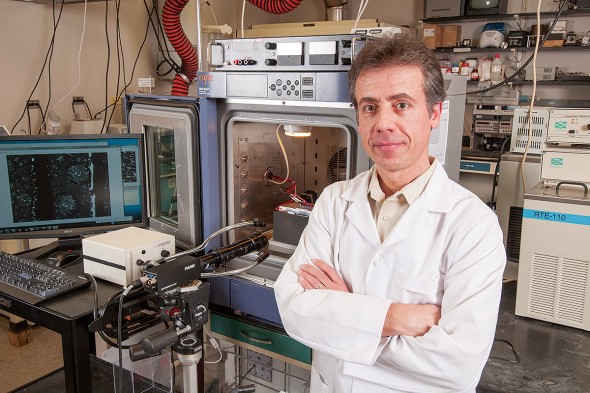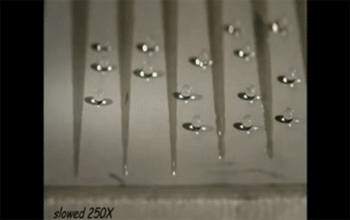Inventor of Year creates ‘portable laboratories’

Constantine Megaridis developed patterned surfaces that can be used to test for harmful substances or disease-causing microbes. Photo: Joshua Clark/UIC Photo Services
Each year, the Office of Technology Management celebrates UIC faculty inventors. The Innovator of the Year Award recognizes researchers who have advanced their inventions toward commercialization. The Inventor of the Year Award honors researchers whose discoveries have the potential for significant impact. The awards, which include a $3,500 prize, were presented May 19.
By patterning surfaces with chemical coatings to produce tracks that attract water, surrounded by areas that repel water, Constantine Megaridis can turn a small piece of paper, plastic, metal or glass into a portable laboratory.
Drops of liquid placed on water-repellent surfaces form beads held together by their own surface tension. The drops roll across the surface unless they come into contact with the “wettable” tracks. Like a balloon pressed against a needle, contact with the track pops or disrupts the shape of the droplet, which merges with the hydrophilic, or water-loving, track.
By embedding these tracks with chemicals that react to various substances in the droplet, such as pollutants or viruses, anyone with a dropper can test water, blood or other liquids for harmful substances or disease-causing microbes.
“This approach can let us test very tiny amounts of fluid with an inexpensive, easy-to-use test that can replace the need for sophisticated, diagnostic equipment requiring significant training in order to use it,” said Megaridis, professor of mechanical and industrial engineering and Inventor of the Year. “These devices can be used anywhere and by anyone with a dropper.
“If we create a surface with multiple separate wettable tracks, each with its own detection chemical, using just a few drops of the liquid, one could test whether there are any of a number of pollutants or contaminants in, say, a body of water that serves as a source of drinking water,” Megaridis said.
Megaridis mentioned Nepal, where recent earthquakes have killed thousands of people and getting supplies to the region is a major challenge.
“If you have these devices in places stored on the ground and ready to go, they can be used when a crisis hits to test a whole population for infectious disease or microbes when the importation of other tests or lab equipment can take a very long time to arrive.”
Megaridis’ patterned surfaces can also help speed the removal of water that forms during dehumidification. Metal surfaces made to condense vapor can be patterned with channels formed by water repellant coatings to guide the liquid away.
He compared the potential of his discovery to that of another common, useful invention.
“Not long ago, testing for pregnancy was much more complicated and involved than it is today,” Megaridis said. Now, tests can be purchased in any drug store and used to get instant results at home.
“Our technology can help simplify other testing in the same way.”

